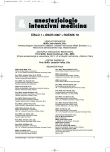The American Society of Anesthesiologists’ (ASA) Classification of Physical Status – time for change?
Authors:
M. Adamus 1; I. Herold 2; Š. Trenkler 3; J. Koutná 1; A. Kropáč 4; J. Závada 5
Authors‘ workplace:
Klinika anesteziologie a resuscitace, Fakultní nemocnice a Lékařská fakulta Univerzity Palackého, Olomouc
1; ARO, Oblastní nemocnice Mladá Boleslav, a. s., Nemocnice Středočeského kraje
2; Klinika anestéziológie a intenzívnej medicíny, Fakultná NsP Jána Adama Reimana, Prešovská univerzita
a Slovenská zdravotnícka univerzita
3; ARO, Nemocnice Šternberk
4; ARO, Vojenská nemocnice Olomouc
5
Published in:
Anest. intenziv. Med., 18, 2007, č. 1, s. 9-23
Category:
Anaesthesiology - Original Paper
Overview
Objective:
The American Society of Anesthesiologists’ (ASA) Classification of Physical Status is a widely used grading system for the preoperative health of the surgical patient.The aim of the study was to assess the consistency of its use by the anaesthetists of several anaesthetic departments in the Czech and Slovak Republics.
Design:
Prospective, observational, multicentre, postal study.
Setting:
4 Czech and 1 Slovak Departments of Anaesthesia.
Materials and methods:
A printed or electronic questionnaire was sent to 101 anaesthetists from 5 departments in the Czech and Slovak Republics. Their length of practice, qualification and attitude to the ASA Classification were recorded. The respondents were asked to ascribe ASA grades to 15 hypothetical patients. The stratified data were compared by statistical tests (chi-square, ANOVA, Kruskal-Wallis).
Results:
Ninety-one of the anaesthetists responded (90%). No difference between the departments was demonstrated. More than 90% of these anaesthetists used ASA classification routinely, 80% considered it useful and only 44% would like to change it. In no case was there complete agreement on the ASA grade: in 2 patients the assessment was restricted to two of the five possible grades, in 7 cases to 3 grades and in 4 patients to 4 grades, respectively. Two cases were assigned all 5 ASA grades. The anaesthetists with higher qualification and longer practice tended to ascribe the patients to higher ASA groups (p < 0.05).
Conclusion:
During a simulation of common clinical scenarios the variation of individual anaesthetist’s assessments was unacceptably high. The ASA grade alone cannot be considered to reliably describe the physical status of the patient.
Keywords:
American Society of Anesthesiologists’ (ASA) Physical Status Classification – anaesthesia – audit
Labels
Anaesthesiology, Resuscitation and Inten Intensive Care MedicineArticle was published in
Anaesthesiology and Intensive Care Medicine

2007 Issue 1
Most read in this issue
- The American Society of Anesthesiologists’ (ASA) Classification of Physical Status – time for change?
- Lev Spinadel – founder of anaesthesiology in Czechoslovakia
- Incidence of postoperative residual curarization following cisatracurium and rocuronium-induced neuromuscular block: a prospective study
- Early urine and blood biochemical changes in experimental model of sepsis
